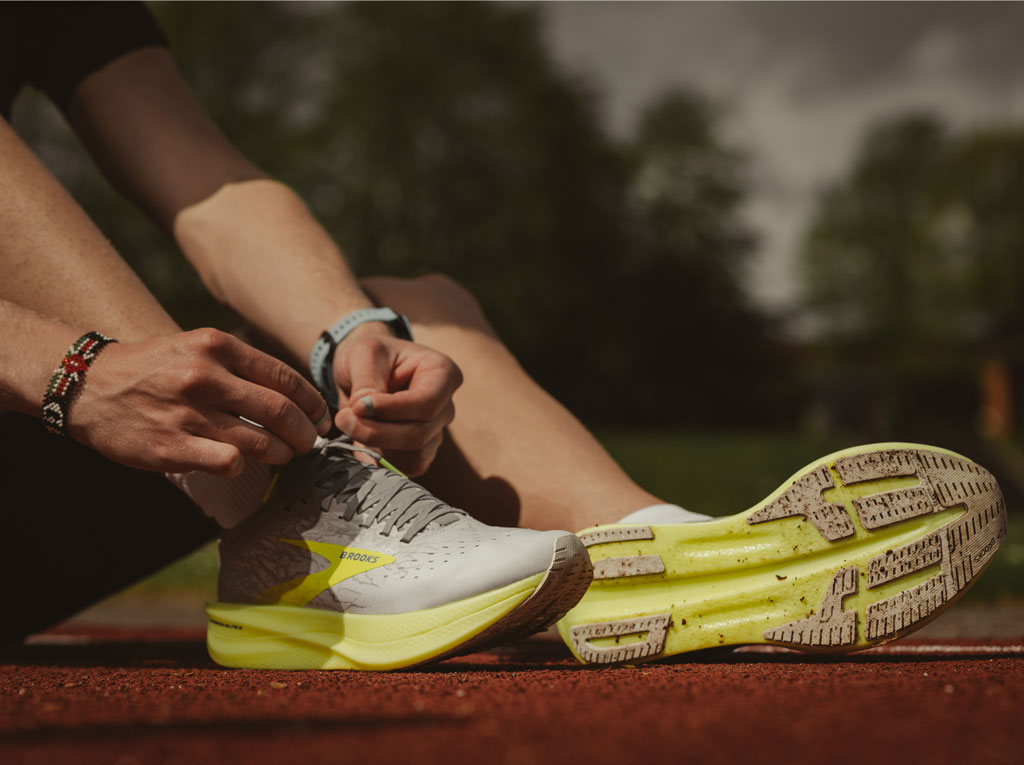Many people who pick up running as a hobby or simply for exercise make the mistake of running in the wrong shoes which can lead to injuries. This is largely because new runners don’t know how to pick running shoes that offer support, fit well, and prevent injuries. But what makes a good running shoe?
Knowing what to look for in running shoes is essential no matter if you are a casual runner or a marathoner. The best shoes for running are specially designed to provide comfort and support. Finding the right running shoe helps to create the balance your body needs to protect itself from injury so you can enjoy the journey!
Choosing Running Shoes: How to Find the Right Running Shoe
New runners often make the mistake of walking into a shoe store and picking any sneaker off the shelf. However, the walls of shoes you see in the stores can distract you from what you need, and not every pair will be suitable for running. Finding the right running shoe is easy if you avoid these common mistakes:
- Assuming your size. Running shoes will fit differently than your everyday casual shoe. If you purchase a shoe based on your everyday size, you may end up with a shoe that is too small, and you will soon find your feet blistered and in pain. Consult an expert in-stores to measure your foot specifically for running shoes.
- Choosing running shoes based on style. Of course, it is okay to find a pair that looks good. However, that shouldn’t be your only factor. There are many more details you must account for, and how you look in your shoe is not at the top of the list.
- Neglecting to test them out before buying. Your feet need to feel what the experience is like. When you set out to find that perfect pair, come ready to run right there in the store. Stores that specialize in running shoes are used to this and will often have an area where you can do this. Some even let you go right outside and hit the pavement. You wouldn’t buy a car without a test drive, so don’t buy your shoes without doing the same.
When shopping in stores for running shoes, don’t just ask the experts, “What kind of running shoes should I buy?” To help them narrow down your choices, you’ll need to tell them how often you run, where you run, how many miles you run per week, and any problems you’re experiencing with your current running shoe if you have one.
Questions to Ask Yourself as You Look for Your Ideal Running Shoe
Every new runner is already wondering, “What kind of running shoes do I need?” To find your ideal running shoe, you’ll need to ask yourself a few additional questions.
Where Am I Running?
Knowing where you are running is a great place to start. Running on pavement versus trail running is significantly different. The soles of running shoes are designed for a specific purpose. The type of tread on the outsole of the shoe is there to keep you safe. Trail running shoes, for instance, are designed to keep your run smooth and can more easily handle the changes in terrain, such as trails with soft, loose gravel, tree roots, and small rocks.
On the contrary, road running shoes are designed to be lighter in weight by only using what is necessary to grip the pavement. There is a reason most marathons are run on pavement and not trails. The density and weight of the shoe change your body’s response to exercise. Training with the right shoe for the right purpose can keep you in peak performance and injury-free.
How Do I Run?
This may seem a little bit silly to ask yourself, but it is important to know how your body works while you run to pick a pair of shoes that complies. Information about the gait of your run along with your body’s specific style of running are both vital indicators to help prevent injury.
Stores that specialize in running shoes will often have the resources available to help you with this process. Some will have a treadmill set up and will record your “run” so that they can help you see exactly how your body responds from heel hit to toe push. Knowing how your foot moves during this process helps not only with the outsole of the shoe, but it aids in understanding the proper midsole and even the necessary ankle support you may need.
While you run, your body is still working to absorb the energy from the impacts on your feet. Those cushioned shoes may feel great, but they may not be helping to provide the support and protection your body needs.
When and How Far Am I Running?
You’ve probably heard that it is best to weigh yourself first thing in the morning because you haven’t eaten anything, so your body is at its lowest weight of the day. If you try on a pair of running shoes first thing in the morning, you’ll find those shoes fit much differently in the afternoon. As the day goes on, your body reacts to the food and water you consume, causing your joints to swell and relax.
The same can be said about the weather and its impact on your body. Running at 3 p.m. in the middle of July in one shoe will feel different than running in the same shoe at 6 a.m. Also, running in one shoe for five miles versus 26 miles will give a completely different feeling as your foot swells from the exercise. Understanding how your body fluctuates in these environments can help in understanding what the best running shoe is for you.
What Kind of Running Shoes Should I Get?
Finding the right running shoe can keep you going for miles. Running shoes are purposefully designed for you so that you can achieve your fitness goals while protecting you from an injury that could keep you on the couch instead of on the road. Once you’ve found that perfect pair, keep the following in mind:
- Your running shoes should be replaced every 300-500 miles. Think of the outsoles of your shoes like the tires on your car. Shoes that are too worn out will prevent them from doing what they were designed for.
- Listen to your body. If your joints ache, you develop blisters, or anything else seems “off” after a run, it is a good indicator that something is wrong. There are many instances where a simple change in running shoes does the trick. However, you may require an orthopedic specialist if the issue is severe enough.
- When you buy new running shoes, repeat the selection process. Every mile logged will change your body and even your running style. Keep supporting that growth with proper shoes.
Preventing Running Injuries with Connecticut Orthopaedics Specialists
The proper pair of running shoes can help you prevent injuring yourself while running. If you still find yourself suffering from running injuries, it is important to be seen by the best orthopaedic doctors in CT. Knowing the type and cause of injury is important in understanding the best route to recovery.
At Valley Orthopaedic Specialists, we have the best orthopaedic surgeons to CT to help you properly treat and recover from a running-related injury. Contact us to get back on the trail in no time!

